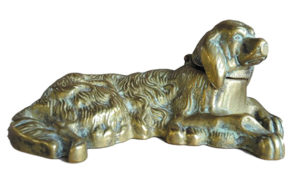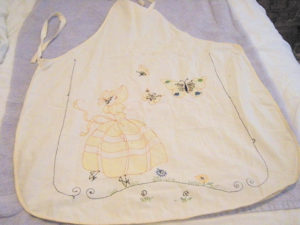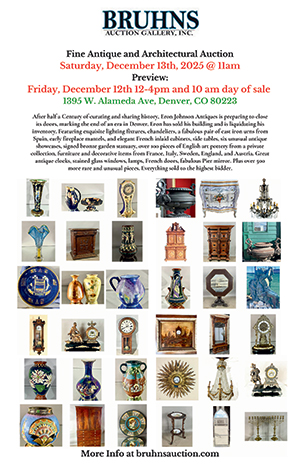 By Anne Gilbert
By Anne Gilbert Q. This bronze dog inkwell was always on top of my late fathers’ desk. It is now on my office desk top. I plan to leave it to my son and would like to know something about it. Is it really bronze? There is no signature. It measures approximately 5 ¼” x 2 ½” long and 2 ½” high. Any idea when and where was it made? Should I insure it?
D.T. – Dallas, TX
A. From your photos, with the underside showing a bronze glint patina, it appears to be bronze. I have seen similar style bronze figurines made in France, supposedly antique. However, since your inkwell doesn’t show a foundry mark, that is puzzling. If it is antique and bronze it could sell in a retail setting for $500 or more. Show it to a professional appraiser for a “hands on” evaluation. The appraiser will determine an insurance price.
Q. I found this charming cotton apron stuffed on the bottom of my late mothers’ kitchen cabinet drawer. She never wore it. It is cotton with an appliqué design of a woman in a 19th century costume, butterfly and flower. It has a few stains. What do you think it could be worth?
B. L. – Evansville, Indiana
A. Your apron dates to the 1920s and is a spinoff of the forever popular “Sun Bonnet” patterns. They have a long history beginning in the early 19th century with the publication of quilt patterns. The popularity grew in the early 20th century with the publication of “Sun Bonnet Baby” primer. Soon the images of the child wearing a large bonnet were turned into quilt patterns, greeting cards, aprons, dishes, etc. A grownup image known as the “Sun Bonnet Lady” followed on aprons and linens. With the stains removed, your apron could sell for $40 in a retail setting.

Q. I found this quaint tin object at a garage sale for $20. I plan to use it for candy. It looks like an antique lithographed tin. The seller said it was very old. It is 7” high. What was it originally used for? Is it worth more than I paid? M. D. – Boynton Beach, FL
A. You got lucky. Your tin is known as a “Roly Poly advertising tin.” It was made for Mayo’s Tobacco Company beginning in 1912, as an entire series of different comic characters. Reproductions have been made ever since. Yours appears to be early. It all began in 1877 when the lithography Company of Huntley, Boore and Stevens first used the technique on tin in England. By the end of the 19th century companies hired artists to showcase their products around the world. Collecting ad tins became trendy in the 1970s. Yours could sell at auction for $500.
Do you have an antique item and need more information? For a personal reply, send a photo, history, size, any signatures with self-addressed stamped envelope and $25 to Anne Gilbert-Strawbridge, 1811 Renaissance Commons Blvd., #2319, Boynton Beach, FL 33426














Follow Us